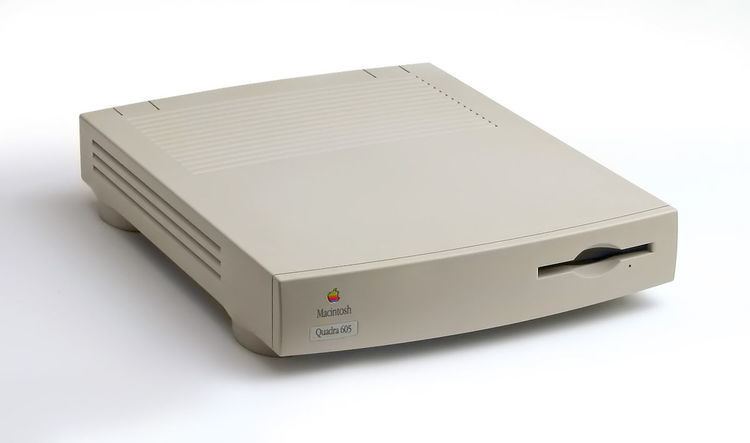Release date October 21, 1993 Discontinued October 17, 1994 | Introductory price 970, 1000, 1300 | |
 | ||
Operating system CPU Motorola 68LC040 @ 25 MHz Memory 4 MB, expandable to 36 MB (official) or 132 MB (later) (80 ns 72-pin SIMM) | ||
The Quadra 605 is an entry level 68040 microprocessor-based Apple Macintosh personal computer code-named "Aladdin" or "Primus" which was released on October 21, 1993 as part of the Quadra series and discontinued on October 16, 1994. It is one of few Macintosh models to not share a case with another machine (although the internal layout is shared with the Performa/LC 475 family.)
Contents
Specifications
Recording is possible at 11 or 22 k samples/second, with filters applied at 3.5 kHz and 7 kHz respectively while recording.
Expansion
The Quadra 605 contains one LC III style 68030-compatible LC Processor Direct Slot. While this is mechanically compatible with previous models' LC PDS (it will take 96-pin or 114-pin LC PDS slot cards) it is not a true LC PDS, but emulates the previous machine's 68030 slot. Due to the success of the LC PDS in earlier Macs and with many expansion options already manufactured, Apple kept the same slot type in these 68040 machines. While the Quadra 605's LC PDS is mostly 68030 compatible, expansion cards made specifically for 030 processors such as 68881 or 68882 FPUs will not work. In addition it could utilize the Apple IIe Card, which allowed the 605 to emulate an Apple IIe.
The Quadra 605 has one SCSI bus, with a 50 pin internal connector (with space for one low profile 3.5" SCSI device) and one 25-pin DB25F external connector. SCSI is provided by an NCR 53C96 controller, which can achieve 6 MB/s internally with a fast enough drive, or 4 MB/s externally.
Two serial ports are provided on a Quadra 605; one 8 pin Mini-DIN Printer port and one 9 pin Mini-DIN Modem port similar to the Printer port, but with an extra pin to supply +5 V power from the ADB power supply. Apple recommends no more than 100 mA should be drawn from this pin.
The Quadra 605, like most other Macintoshes manufactured before 1999, includes an Apple Desktop Bus port for use with a keyboard/mouse or other low-speed low-power peripherals. Devices may be powered from the ADB port; Apple recommend a maximum combined current draw of 200 mA over a maximum of three ADB devices.
Some earlier models also contain a ROM SIMM socket, located just to the left of the VRAM. No SIMMs were made for this slot, and most boards only contain the solder pads indicating its position. The ROMs as used in production machines are two surface mount chips located directly behind the CPU. Quadra 605s use a 1024 kB ROM, version 7C.
PowerPC Upgrade
The Quadra 605 was compatible with Apple's Macintosh Processor Upgrade Card which provided a 50 MHz PowerPC 601 CPU. DayStar Digital and Sonnet manufactured 100 MHz versions of this card which could also be used in the Quadra 605.
Installation of these cards was inconvenient at best, as LC PDS expansion cards had to be removed in order to fit the processor upgrade.
Miscellaneous
Some Quadra 605s have a Cuda reset switch which is used to manually reset the PRAM, located towards the rear of the motherboard just to the front of the audio out port and labeled "S1". Others do not include this switch, instead having two solder pads within a silkscreened square.
The keyboard power-on key will not start up a Quadra 605 as there is no soft power-on. Only the rocker switch at the back will turn a Quadra 605 on or off. Pressing the power-on key while running is the same as selecting shut down in the Finder, and once a Quadra 605 has completed its shutdown process it will prompt the operator to manually turn it off.
Quadra 605s have no reset button or programmer's button, but key combinations can perform the same functions. To reset, users can hold down the Command, Control and Power keys. For a programmer's button click, users can hold down the Command and Power keys. There are some hard crash situations where even this is not enough to restore the system, in which case the power switch is the only recourse.
A modified Quadra 605 motherboard was used as the basis of early Apple Interactive Television Box prototypes. Later prototypes used their own board design, but still retained a resemblance to the 605.
Gestalt IDs
The standard Gestalt ID for a 25 MHz Quadra 605 is 94. The ID of the logic board that the Quadra 605 shares with other LC/Performa models depends on two things. Jumper J18 (located just behind the hard drive) will identify the computer as a Quadra 605 (ID 94 @ 25 MHz) if it is ON, and as an LC475/Performa 47x (ID 89 @ 25 MHz) if it is OFF. Over-clocking and under-clocking the motherboard also changes the Gestalt ID. A list of Gestalt IDs returned with various logic board modifications (speed as reported by Newer Technology's "Clockometer") are as follows
System software
A standard model Quadra 605 is capable of running classic Mac OS versions 7.1, 7.1.1 (Pro), 7.5, 7.5.1, 7.5.3, 7.5.5, 7.6, 7.6.1, 8.0, 8.1. With a PowerPC upgrade installed, it can run 8.5, 8.5.1, 8.6, 9.0, 9.0.1, 9.0.2, 9.0.3, 9.0.4 and 9.1. Versions of System Software below 7.5 require the use of System Enabler 065. If a Quadra 605 is running a version of System 7.1, over-clocking it from the standard 25 MHz to 33 MHz will change the gestalt ID, but the enabler will recognise the new ID. Under-clocking to 20 MHz however will change the gestalt ID to one the enabler doesn't recognise as compatible, and the system won't boot. System 7.5+ is not affected by this issue.
